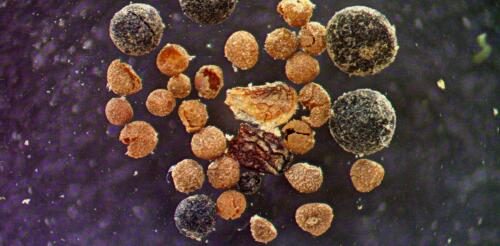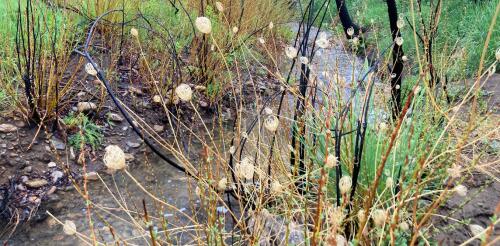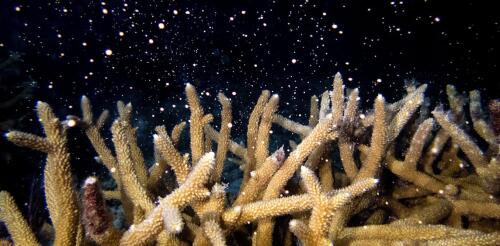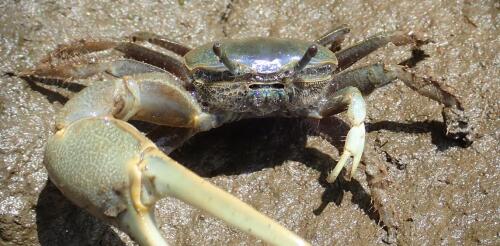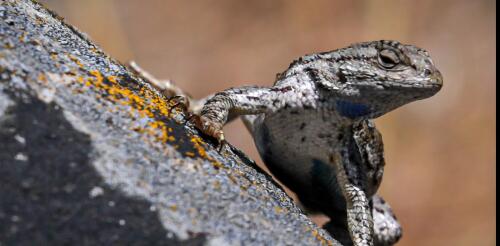Ecosystems
As we focused our microscope on the soil sample for the first time, bits of organic material came into view: a tiny poppy seed, the compound eye of an insect, broken willow twigs and spikemoss spores. Dark-colored spheres produced by soil fungi dominated our view. These were unmistakably the remains of an arctic tundra ecosystem – and proof that Greenland’s entire ice sheet disappeared more recently than people realize. These tiny hints of past life came from a most unlikely place – a handful of soil that had been buried under 2 miles of ice below the summit of the Greenland ice sheet. Projections of future melting of the ice sheet are unambiguous: When the ice is gone at the summit, at least 90% of Greenland’s ice will have melted. Results of an ice sheet model show how much of Greenland’s ice sheet survives when the ice is gone from the Camp Century (white dot), GISP2 (red dot) and DYE-3 (black dot) ice...
A tiny, vibrant world thrives along the rocky bottom of most streams. As sunlight filters through the water, mayfly nymphs, no larger than your fingernail, cling to algae-coated cobbles. Their brushlike mouthparts scrape the greenish coating, leaving faint trails as they feed. Six spindly legs anchor them against the current, while feathery gills wave gently, drawing oxygen from the flowing water. This scene is common in well-maintained creeks and streams that flow through populated areas. But when wildfires sweep through, the toxic materials left behind can devastate this ecosystem. When you think of urban wildfires, you might picture charred trees and houses. But beneath the surface of nearby streams, fires can also cause a silent upheaval – one that affects populations of creatures that are important indicators of the water’s health. Images of some of the benthic invertebrates that help keep streams healthy, and whose disa...
The world’s coral reefs are like underwater cities, bustling with all kinds of fish and sea animals. Coral reefs cover less than 1% of the ocean, but they support an estimated 25% of all marine species, including many important fish species. The economic value of the services that these complex ecosystems provide is estimated at over US$3.4 billion yearly just in the U.S. Today, rising ocean temperatures threaten many reefs’ survival. When ocean waters become too warm for too long, corals expel the colorful symbiotic algae, called zooxanthellae, that live in their tissues – a process called coral bleaching. These algae provide the corals with food, so bleached corals are vulnerable to starvation and disease and may die if the water does not cool quickly enough. With global ocean heat at record levels, scientists have confirmed that a global coral bleaching event is underway. Since the beginning of 2023, corals have been dying in the Indian, Pacific and Atlantic...
Nine years ago, I stood on the muddy banks of the Great Marsh, a salt marsh an hour north of Boston, and pulled a thumb-sized crab with an absurdly large claw out of a burrow. I was looking at a fiddler crab – a species that wasn’t supposed to be north of Cape Cod, let alone north of Boston. As it turned out, the marsh I was standing in would never be the same. I was witnessing climate change in action. The Great Marsh is on the Gulf of Maine, the piece of the Atlantic that extends approximately from Cape Cod, Massachusetts, to Nova Scotia, Canada. The marshes along the gulf are critical breeding sites for many bird species. But the water there is warming faster than almost anywhere else on the planet. And with warming water comes warm-water species. Marsh grass is essential for both habitat and adapting to sea-level rise in the Great Marsh. David S. Johnson Maryland blue crab and black...
Climate change is threatening the survival of plants and animals around the globe as temperatures rise and habitats change. Some species have been able to meet the challenge with rapid evolutionary adaptation and other changes in behavior or physiology. Dark-colored dragonflies are getting paler in order to reduce the amount of heat they absorb from the sun. Mustard plants are flowering earlier to take advantage of earlier snowmelt. Lizards are becoming more cold-tolerant to handle the extreme variability of our new climate. However, scientific studies show that climate change is occurring much faster than species are changing. Zebrafish have evolved to thrive in water a degree or so warmer than normal, but they struggle to survive at higher temperatures. isoft/E+ Getty Images What is evolutionary adaptation? The word “adaptation” is used in many ways by climate scientists, but it has a...
